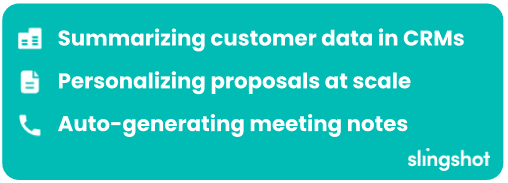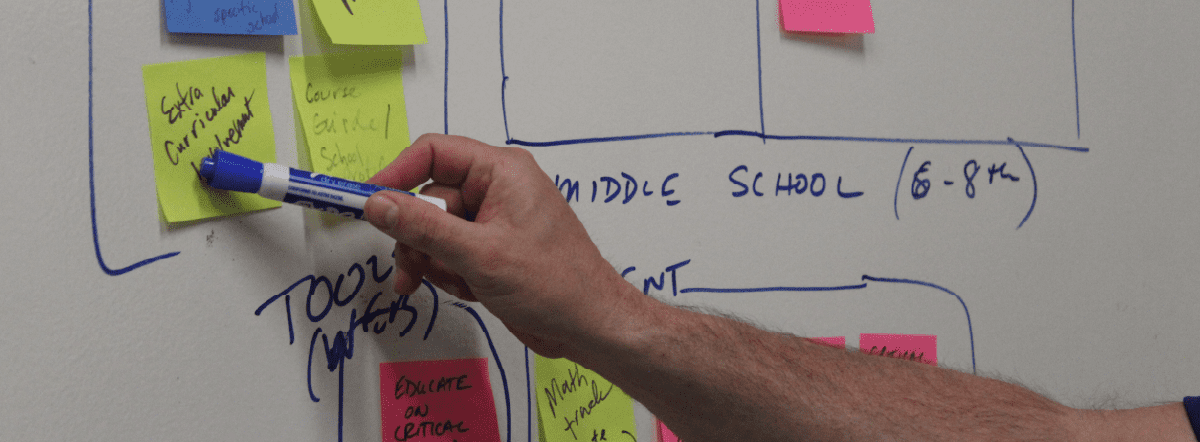Most business leaders want to move fast. But when it comes to AI, too many feel stuck before they even begin.
AI is everywhere, but clarity is rare. There’s pressure to do something with the technology, but no clear blueprint for what drives business value. The result can be analysis paralysis, long delays, bloated pilot programs, and high-stakes bets that take months or years to show returns.
But it doesn’t have to be that way.
At Slingshot, we’ve seen how leaders are winning quickly. They aren’t chasing big moonshot projects; instead, they’re finding low-risk, high-reward ways to apply AI today. This post examines six effective strategies that business leaders are using to transform curiosity into clarity and early traction into a competitive advantage.
Summary
AI doesn’t have to be a big leap. The most successful teams are starting small and seeing results fast. By focusing on time-saving tasks and improving existing workflows, leaders are using AI to boost productivity and gain early wins. These six simple strategies can help you move forward with clarity and confidence.
1. Time-Saving at Scale Is the Fastest ROI
For CEOs, speed matters. But speed without value is wasted effort. So what counts as a win?
“It’s a win if there’s an increase in productivity or value delivered,” said David Galownia, CEO of Slingshot. “AI tools cost money. There has to be something tangible in return.”
That return often comes in the form of time savings, especially when those efficiencies unlock more valuable work across a team. Think less about replacing jobs and more about freeing your staff to focus on strategic impact.
“Anything that creates visible impact, like faster decisions, quicker proposals, improved customer response time. That’s where AI starts paying off,” added Sarah Bhatia, Principal Product Lead at Slingshot.
Smart CEOs are not treating AI as a side project. They are utilizing it to enhance high-volume, cross-team workflows, including lead generation, reporting, and proposal writing. These are areas where speed and accuracy can have a direct impact on the bottom line.
2. Smaller Pilots, Bigger Momentum
Big change doesn’t have to mean big risk. Instead of launching company-wide initiatives, successful leaders first look for focused internal wins.
These are often low-risk applications of AI in marketing, operations, or customer outreach. The cost of experimentation is low, and the payoff is clear.
“You don’t need a top-down rollout,” said David. “Start by looking inward. What are you already doing that AI could make smarter?”
Examples include:
- Summarizing customer data in CRMs
- Personalizing proposals at scale
- Auto-drafting job descriptions or meeting notes

These kinds of updates don’t require starting from scratch. By layering AI into tools and processes teams are already using, leaders can create fast value with less friction. Sarah put it simply: “AI is most powerful when it strengthens what’s already working.”
3. Find Your Internal Champions
The fastest AI wins don’t usually come directly from the CEO. Instead, they come from small, curious teams empowered to experiment.
“You can’t do it alone,” said David. “It’s about creating the right messages and opportunities, then letting your team lead.”
At Slingshot, that means identifying AI advocates across roles; not just in engineering, but in design, sales, and support. The result is cross-functional experiments, quick wins, and rising momentum.
“Nobody loves doing tedious manual tasks,” Sarah pointed out. “AI earns trust when it tackles those jobs: things like content generation, meeting notes, or internal reports.”
Those early wins build both credibility and curiosity. They help spread enthusiasm organically across departments.
4. Beware the AI Hype Trap
One of the most prominent mistakes business leaders make is treating AI as a silver bullet. Or worse, as a checkbox.
“Everything doesn’t need a chatbot,” said Sarah. “If a tool isn’t solving a pain point, it’s just a distraction.”
It’s easy to get swept up in shiny tools and flashy demos. However, if these tools aren’t tied to tangible business outcomes, you just add complexity without clarity.
Leaders also need to avoid the trap of unmeasured progress. If you’re not tracking impact, like time saved or cost reduced, you won’t know what’s working or where to focus next.
“Not having success metrics is a big issue,” Sarah emphasized. “There still needs to be KPIs, just like any other product.”
5. Security and Strategy Go Hand in Hand
While speed and experimentation are critical, smart businesses also consider security from day one.
“If you don’t understand what data is being used and where it’s going, that’s dangerous,” said David. “You’ve got to ask the right questions.”
AI tools can unintentionally expose sensitive information or create access gaps. That’s why responsible implementation includes:
- Access controls for LLMs and documents
- Clear guidelines on what data to use
- Ongoing training to upskill teams safely
“Your team needs reassurance,” said David. “You’re not implementing AI to cut jobs. You’re using it to help people do more, provide more value, and focus on the work that matters.”

6. Move with Purpose, Not Panic
AI shouldn’t replace your strategy. It should support it.
“If all you’re doing is using AI only to be more efficient or save money,” David warned, “it’s a race to the bottom.”
Winning companies aren’t just optimizing; they are innovating. They utilize AI to deliver more value, build smarter tools, and deepen customer relationships. It’s creating real advantages, not just cost savings.
“The businesses that are going to succeed,” Sarah said, “are the ones using AI to enhance their strengths, not abandon them.”
What Business Leaders Should Be Asking Now
If your company is still figuring out where to start, here are five questions to ask your team today:
- What problem are we trying to solve?
- Who owns it?
- What existing tools or workflows can we improve with AI?
- How will we measure the impact?
- What’s the smallest win we can ship fast?
The companies making real progress aren’t always the loudest. They are the clearest.
Final Thought: Be Curious, Not Cautious
AI doesn’t need to be a 12-month initiative. It doesn’t require a new department. But it does need leadership that is curious, clear, and committed.
Start small, measure well, and move fast with purpose. And if you’re not sure where to begin, ask this simple question: What’s the smartest thing we can try this week?
Ready to Start an AI Initiative?

Written by: Savannah Cherry
Savannah is our one-woman marketing department. She posts, writes, and creates all things Slingshot. While she may not be making software for you, she does have a minor in Computer Information Systems. We’d call her the opposite of a procrastinator: she can’t rest until all her work is done. She loves playing her switch and meal-prepping.

Expert: David Galownia
David excels at propelling Slingshot towards their goals and oversees the strategic direction of the company. He’s been described as ‘intense, driven, caring, and passionate’ both at work and play. At work, he enjoys watching his team explore, imagine, and reinvent to do the best by their clients. At play, he drives Karts at insanely high speeds and scares his wife half to death. It’s all or nothing. Which means he gives it all.

Expert: Sarah Bhatia
Sarah Bhatia brings people together. In her decade plus of product and product-adjacent experience, her focus has been on cross-functional collaboration, asking lots of questions, and getting big results. She excels at strategy development, and getting the right brains in the room to solve big problems. Sarah would describe herself as a daredevil, because she’s not afraid to ask “dumb“ questions, get smart answers, and take (calculated) risks.




